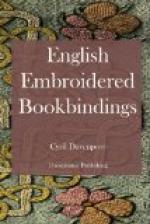Henshaw, Horae Successivae. London, 1632.
[Illustration: 40—Henshaw, Horae Successivae. London, 1632.]
Henshaw’s Horae Successivae, printed in London in 1632, is bound in white satin, and measures 4-1/2 by 2 inches. It is very delicately and prettily worked in a floral design, the same on both sides, and is remarkable for its simplicity—a flower with stalk and leaves in the centre, one in each corner, and an insect in the spaces between them. The centre flower is a carnation, round it are pansy, rose, cornflower, and strawberry, while between them are a caterpillar, snail, butterfly, and moth. All of these are delicately worked in feather-stitch in the proper colours, and edged all round with fine gold cord; the stalks are of the same cord used double. On the strawberries there is some fine knotted work.
The back is divided into four panels, containing a cornflower, rose, pansy, and strawberry, worked exactly in the same way as their prototypes on the sides. There were several gold spangles on sides and back, but many of them have been broken off, and on the front edges of each board are the remains of pale green ties of silk.
[Illustration: 41—Psalms. London, 1633.]
Psalms. London, 1633.
A copy of the Psalms, printed in London in 1633, is bound in white satin, embroidered in coloured silks worked in satin-stitch, and measures 3 by 2 inches. On the upper board is a gentleman dressed in the style of the period, with trunk hose of red and yellow, a short jacket of the same colouring, and a long, reddish cape. He has a broad-brimmed hat with coloured feathers, a large white collar, and a sword in his right hand. Near him is a beetle, and in the sky a blue cloud, and he is standing upon a grass mound. On the lower board is the figure of a lady in a deep pink dress, with white collar and cap. She holds a tall red lily in her right hand, and in the upper left-hand corner is a small cloud under which the sun is just appearing, and in the lower corner is a small flower. The lady is standing upon a small green mound. The outlines of both figures, as well as the inner divisions between the various garments, are marked with a gold or silver thread.
The back is divided into four panels, in which are a fly, a rose, a larger fly, and a blue flower. The outlines and legs of both the insects were marked originally with small pieces of peacocks’ feathers, but the upper fly has lost most of these; the lower one, however, more ornamental, shows them clearly, and has the thorax still in excellent preservation, glittering with little points of green and gold. There is one broad ribbon of striped silk attached to the lower board.
This little book, which is in a wonderful state of preservation, has been always kept in the beautiful embroidered bag which I have described already on p. 16.
Psalms. London, 1635.




